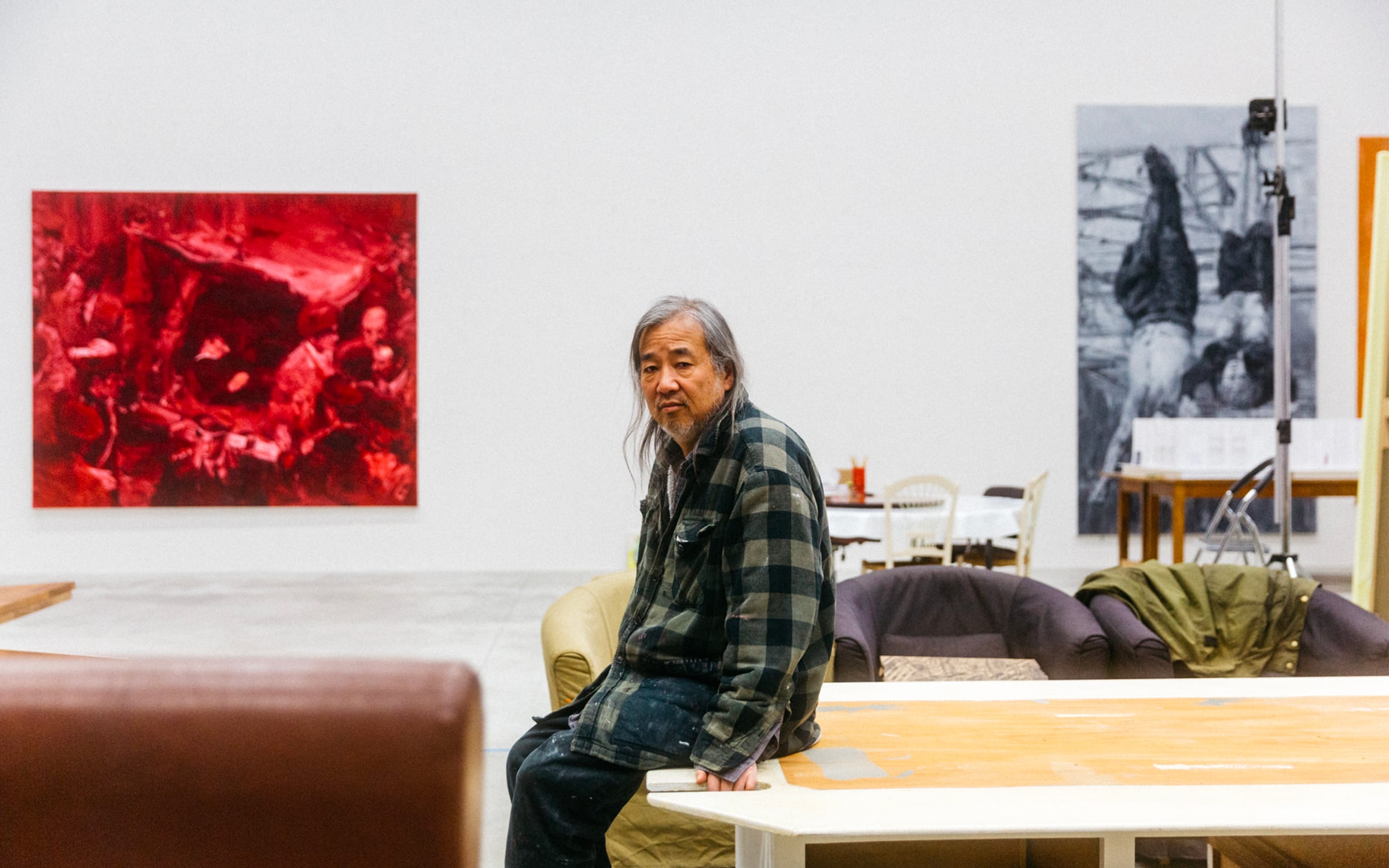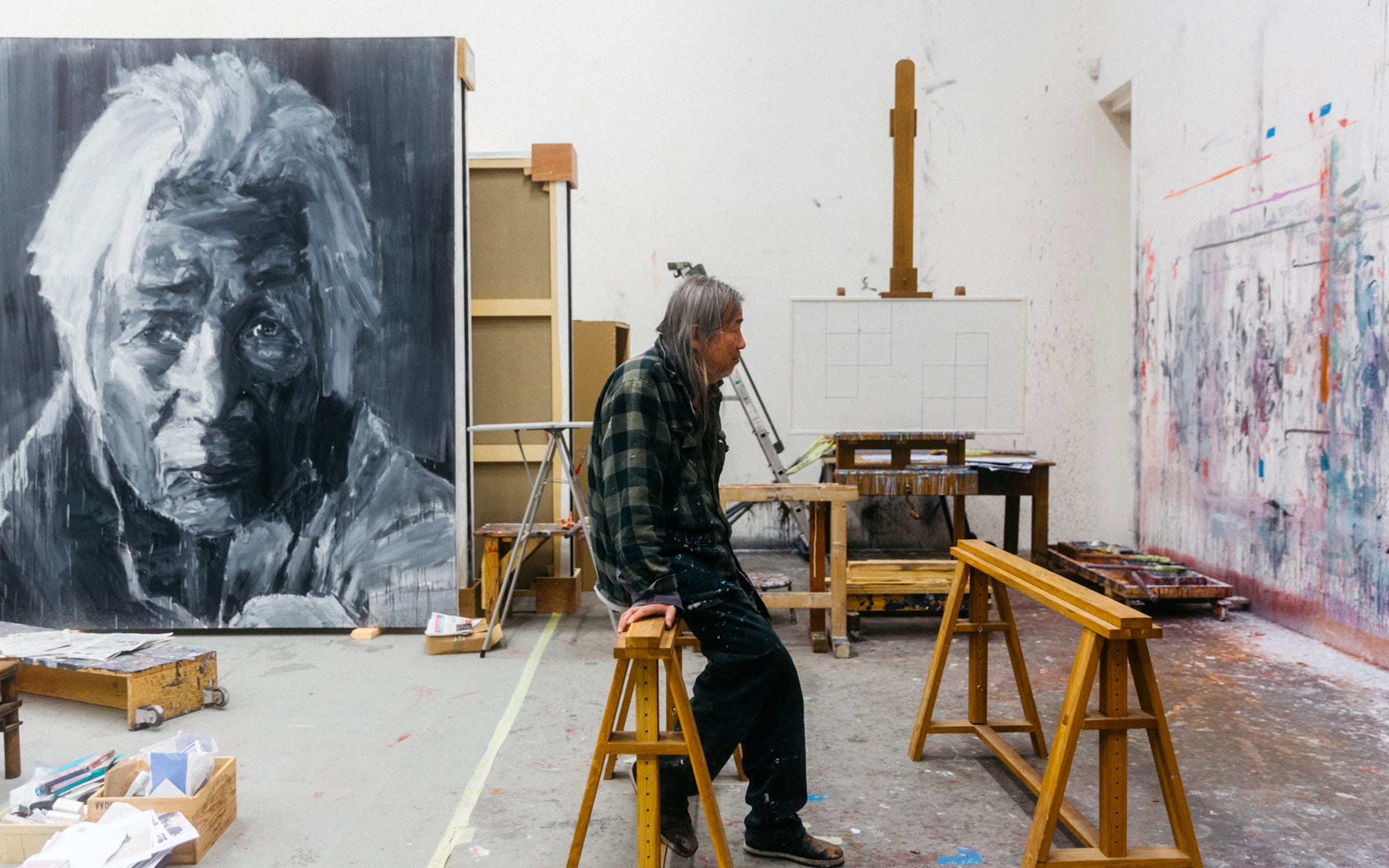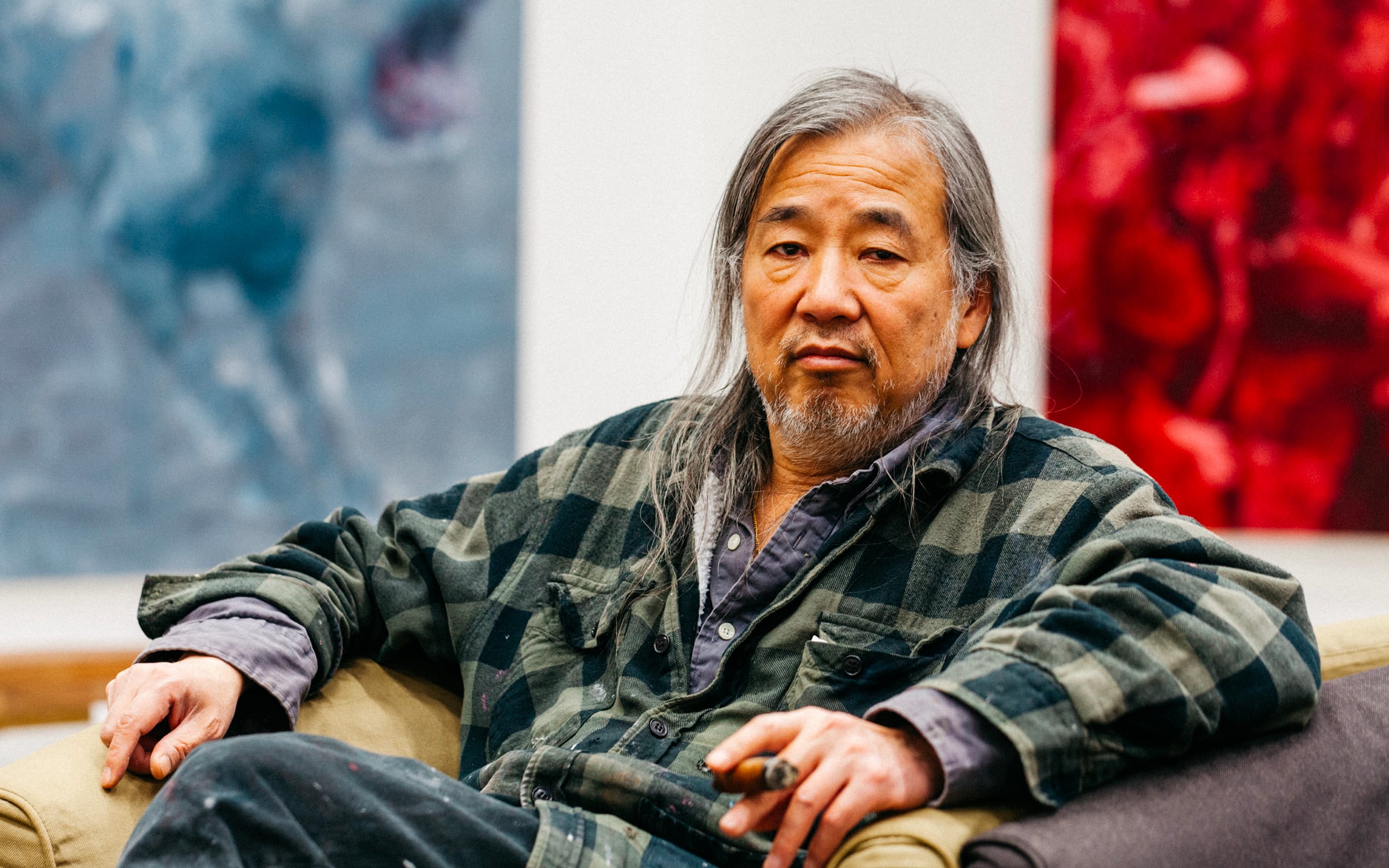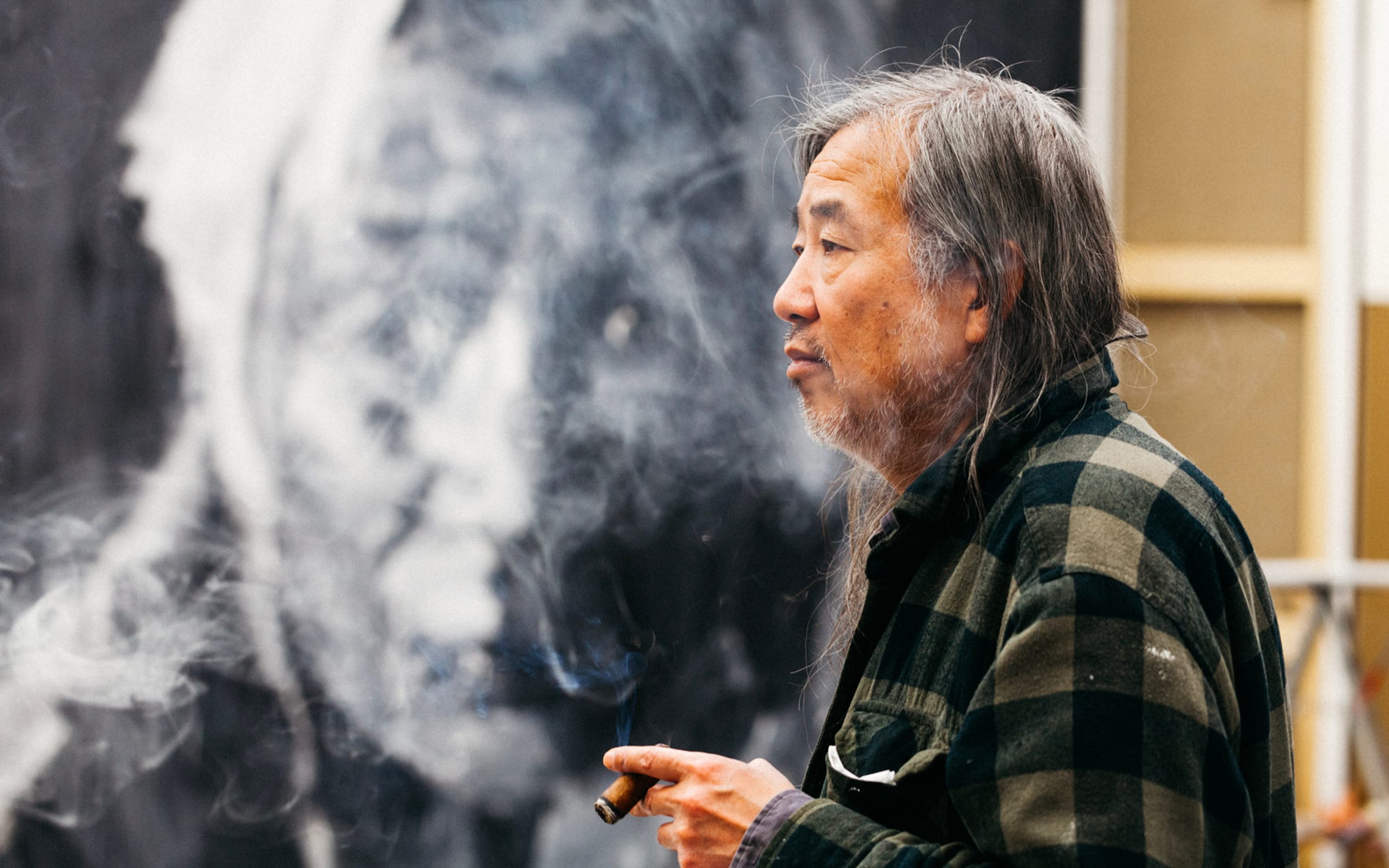In 2009, Yan Pei-Ming became the first Chinese artist to show in the Louvre, with The Funeral of Mona Lisa (2008). The grisaille-like oil on canvas polyptych features an enlarged painting of Da Vinci’s Mona Lisa (ca. 1503-1506) at the center, bordered by a portrait of Yan’s father on his hospital bed on one side and the artist’s self-portrait on the other. A decade later, Yan presented another family portrait in another historical setting for ‘The Man Who Weeps’, his 2019 solo show at the Musée des Beaux-Arts de Dijon. Installed in a 15th-century ceremonial hall was My Mother (2018): three monumental grayscale oil paintings of the artist’s mother.

‘The Man Who Weeps’ was something of a return for Yan. Born in Shanghai in 1960, he left China for France at the age of 19 and ended up in Dijon, where he graduated from the École Nationale Supérieure des Beaux-Arts in 1986. He made a name for himself with the monochromatic full-frontal portraits that he started painting in the mid-1980s, using a mop-sized brush to create fluid, expressionist marks on the image plane. Mainly painted in grayscale, both the guilty and the innocent have their place in this study of humanity's many faces. Subjects range from political and cultural figures like Bashar al-Assad, Barack Obama, Bruce Lee, and Marylin Monroe to anonymous workers, prisoners, and refugees. More figures will join the series, including Angela Merkel and Joe Biden, in Yan’s aptly titled solo show ‘Portraits’ at the Francisco Carolinum Linz museum in Austria, curated by art historian Alfred Weidinger and the artist himself.
Often based on preexisting images, Yan’s monumental faces resonate with the Chairman Mao portraits he painted for his district’s propaganda service as a high school student in Shanghai. But Yan is quite vague about that backstory in interviews. As he has said himself: ‘Artists can’t exist without myth.’ Nevertheless, he openly acknowledges the strategy behind making Mao’s portrait part of his artistic repertoire. ‘Mao is an image and the history of China,’ the artist told curator You Yong in 2005. ‘With Mao,’ he continued, people ‘would understand where I came from.’ It worked. Following a solo show of Mao portraits at Galerie Anne de Villepoix in 1991, he participated in the landmark ‘China Avant-garde’ exhibition at Berlin’s Haus der Kulturen der Welt in 1993, winning the prestigious Prix de Rome the next year.

Making about 20 a year, Yan considers his painted portraits his life’s project. More than subjects, the people he paints are the foundation of his artistic inquiry, and he counts himself among them. Yan has painted over one hundred self-portraits, mostly in oil on canvas. These encompass the early studies of his face in the mid-1990s; the portraits where the artist pictures himself dying from the 2000s; and recent portraits where he depicts himself in a Christ-like cruciform position. There is a performativity to these studies. When Yan participated in ‘Zone of Urgency,’ a show curated by Hou Hanru for the 2003 Venice Biennale, he showed the grayscale oil on canvas Self-Portrait as Anti-Riot Cop (2003), in which he appeared wearing riot gear. This obsession with his own image highlights an interrogation of mortality that defines Yan’s work – a study reminiscent of the Old Master Rembrandt, whose portraits are the stuff of art history.
‘The legacy of past European masters is inevitable for contemporary art,’ Yan explains. But while his paintings can be read within the grand tradition of history painting, his works delve into entirely different problems than those of his art historical forebears. The orderly brutality of Manet’s The Execution of Emperor Maximilian (1868-1869) and the horrifying cry of Francis Bacon’s pope in Study after Velázquez's Portrait of Pope Innocent X (1953) are nowhere to be found in Yan’s paintings. No matter how universal his subjects, how somber his palette, or how expressive his paint strokes, there is a bluntness to Yan’s paintings, which speaks to the fact that he creates them from photographs; a process he describes as an ‘execution’. Stripped of compositional artifice, with monochrome backgrounds rendered in the same tones and strokes as his subjects’ faces, Yan’s portraits reveal no truth except the substance of pictorial matter – the thing that inevitably remains once a person is gone.

That enduring trace circles back to the specter of death that Yan confronts in his paintings. Two years after participating in the 2003 Venice Biennale, he staged his first solo show in China, ‘Homage to my Father, Dijon-Shanghai-Guangdong’, at the Shanghai Art Museum and Guangdong Museum of Art in 2005. Curated by Li Xiangyang and Wang Huangsheng, among the exhibited works were paintings of figures laying on their death bed, and near-white paintings of flowers from Yan’s father’s funeral.
But ‘Homage to my Father’ was not only an act of remembrance for Yan; it was a bridging of his expanded sense of belonging. Organized as part of the diplomatic cultural season known as the French Year in China in 2005, the exhibition positioned the artist within the field of cultural diplomacy – a positioning that has endured. He produced ‘Shanghai Children’ for the French Pavilion at the Shanghai World Expo in 2010: grayscale oil on canvas portraits of 21 children displayed on the outer wall of the pavilion, which housed works by Auguste Rodin, Jean-François Millet, Édouard Manet, Vincent van Gogh, Paul Gauguin, Paul Cézanne, and Pierre Bonnard. More recently, Yan joined the cultural delegation accompanying the French president Emmanuel Macron on his state visit to China in April 2023.
Lately, Yan has started working on vast compositions that are no longer anchored to the kind of abstract non-place that he is known to set his portraits in. Invited by the Musée d'Orsay on the bicentenary of Gustave Courbet’s birth in 2019, he presented A Burial in Shanghai. This six-meter-wide painting revisits the 19th-century master’s A Burial at Ornans (1849-1850), known as the first painting in Western art history to treat a provincial funeral at the same scale of history painting. Painted in shades of near-black with white highlights picking out figures in the dark, Yan depicted the burial of his mother against the backdrop of urban Shanghai. ‘It’s the largest composition I have ever made,’ notes Yan. Describing ‘all the great classical painters’ as ‘excellent composers,’ he says the painting gave him an opportunity to develop his interest in composition on a grand scale.

Yan created another large composition for his solo exhibition ‘In the Name of the Father’ at the Musée Unterlinden in 2020. Installed as a pendant to Grünewald’s Isenheim Altarpiece (1512-1516), the oil on canvas diptych Pandemic (2020) is a contemporary history painting that Yan created during the COVID-19 lockdown at Ivry-sur-Seine, near Paris. ‘At that time, I was alone in my studio, imagining the end of the world,’ he remembers. Dominated by coal-black darkness and ghostly white highlights, one figure in a hazmat suit stands on the outskirts of Paris with a shovel, amid an unsettling pile of body bags painted with heavy agitated brush strokes.
When Yan talks about Pandemic (2020) now, his words describe a shift both in the state of the world and in his own practice: ‘When the WHO declared the end of the pandemic, my characters took off their masks and suits.’ The tone recalls how he feels when looking at paintings by artists of history who came before him: ‘Every time I see the works of these great masters, it gives me courage, strength, and hope.’
Yan Pei-Ming is represented by MassimoDeCarlo (Milan,London, Paris) and Thaddaeus Ropac (London, Paris, Salzburg, Seoul).
‘Portraits’ is on view until 13 August, 2023 at Francisco Carolinum, Linz
Jun Zhang is a writer based between Canton and Paris.
All photos by Baptiste de Ville d’Avray for Art Basel.
Published on May 19, 2023.